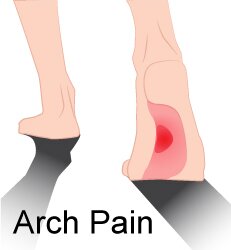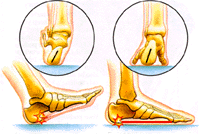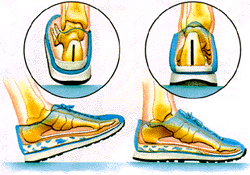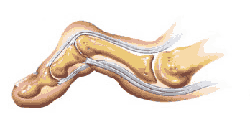As you walk your heel swings from side to side very slightly, like the pendulum on a clock. If, however, your heel swings too far when you walk or run, your foot may be overpronating, or flattening too much. This incorrect movement stresses and weakens parts of your foot. Over time, you may develop symptoms in your feet ranging from a change in shape to pain when you walk.
OurHealthNetwork Articles
Sprained Ankle
Description
Sprained ankles may occur frequently and become a serious medical problem, destabilizing your every step and putting you in jeopardy of taking a disastrous fall. Ankle sprains can be divided into groups of mild, moderate, or severe. These are often graded as Grade 1, which is a mild sprain, Grade 2 that is more severe and may be associated with longer recovery and may involve a partial tear of ligaments or tendon. Grade 3 often refers to a complete tear of the ligaments and tendon and requires longer periods of care and in severe cases may require surgical treatment.
Shin Splints
Description
Shin splints is a term used to describe several conditions due to inflammation of the muscle and tendon attachments to the lower leg bone (tibia). Medial Tibial Stress Syndrome is also used to describe shin splints. The term shin splints should not be used to describe specific tenderness on one area of the bone such as a possible stress fracture. Shin splints are characterized by pain and tenderness along the inner aspect of the lower 2/3 of the tibia. The posterior tibialis and soleus muscles attach to the tibia in this area. The function of these muscles is to support the arch of the foot and to help the calf muscles direct the foot. Shin splints are usually due to repetitive use of these muscles, resulting in an inflammation at their attachment sites on the bone.
This term usually applies to pain in the front of the leg, occurring anywhere between the ankle and the knee. However, it can also refer to pain in the inner side of the lower leg. Walking, running, or jumping usually initiates the pain in both of these areas. In extreme cases one can have pain in these areas while just standing still.
Hammertoes
Description
Hammertoes are the result of deformed toe joints, tight tendons that attach to the toe, and misaligned toe bones. The usual appearance of a hammertoe is a toe bent upward at the middle toe joint, so that the top of this joint rubs against the top of the shoe. The remainder of the toe is bent downward so that, instead of the entire toe bearing weight, only the tip of the toe bears weight. Pain can occur on the top of the toe, the tip of the toe, or in both areas. |
|
Mallet toes and claw toes are similar to hammer toes, except that different joints on the toe are affected. The joint at the end of the toe buckles in a mallet toe, while a claw toe involves abnormal positions of all three joints in the toe. Hammertoes, mallet toes, and claw toes have similar symptoms and causes; therefore, treatments and preventive measures used to relieve hammertoe pain, frequently provide relief to painful mallet and claw toes as well.
Hammertoes are classified based on the mobility of the toe joints. There are two types:
Flexible hammertoes: the joint has the ability to move. This type of hammertoe can be straightened manually.
Rigid hammertoes: the joint does not have that same ability to move. Movement is very limited and can be extremely painful.
Hammertoes usually start out as mild deformities and get progressively worse over time. In the earlier stages, hammertoes are flexible and the symptoms can often be managed with changes in shoe styles and foot care products. But if left untreated, hammertoes can become more rigid and painful. Corns are more likely to develop as time goes on-and corns never really go away, even after trimming. In more severe cases of hammertoe, corn lesions may evolve into severe ulcerations. These lesions frequently occur in patients who have vascular disease or are Diabetic with neuropathy. The ulcerations can extend to the bone and result in infection and possible loss of digit or amputation.
Plantar Fasciitis
Overview
Heel pain affects over 2 million Americans each year and can be responsible for mild discomfort or even debilitating pain.
The two most common causes of pain in the bottom of the heel, the arch, or both the heel and the arch, are plantar fasciitis and heel spurs.
Plantar fasciitis is an inflammation of the plantar fascia. The plantar fascia is  a thick ligamentous/fibrous band on the bottom of the foot that is attached to the heel, and runs forward to insert into the ball of the foot. Plantar fasciitis is a painful inflammation of this band, which usually occurs at its attachment to the heel; however, the inflammation and pain of plantar fasciitis can occur anywhere on the plantar fascia.
a thick ligamentous/fibrous band on the bottom of the foot that is attached to the heel, and runs forward to insert into the ball of the foot. Plantar fasciitis is a painful inflammation of this band, which usually occurs at its attachment to the heel; however, the inflammation and pain of plantar fasciitis can occur anywhere on the plantar fascia.
A Heel Spur is a piece of calcium or bone that sticks out from the bottom of the heel bone, and lies within the fibers of the plantar fascia. When walking, the spur may apply undue pressure to the plantar fascia. This produces inflammation and pain in the heel, which at times may radiate into the arch
Aging Feet
Overview
By the time we reach 65, most of us will have walked more than 75,000 miles (3 times around the equator), and bore several million tons of weight on our feet. Over time, this abuse takes its toll on our feet and alters the structure of the feet. The most common changes that occur in the feet are listed below.
Increase in foot size and width.
The bottoms of the feet lose the fatty pads that cushion the feet (especially the balls of the feet), and the skin becomes thinner.
Flattening of the arch.
Ligaments And Tendons Become Looser And Weaker
Dry, Flaky Skin
Thick and discolored toenails.
Crooked toes and feet.
Dry Skin & Cracked Heels
- Description
-
Dry skin on any part of the body can be annoying and can cause flaking and cracking of the skin, redness due to scratching, and unsightly patches of thick/hard skin. However, when dry skin occurs on the feet, the symptoms of discomfort are magnified due to shoe wear, the stretching of the skin on the feet each time we step down, and by certain synthetic materials in the socks and shoes that dry the skin out even more. Because of the confining nature of the shoes we wear and the lack of fresh air that hits the skin of the feet due to our socks and shoes, dry feet need specialized care in order to prevent pain.
Obesity and the Feet
Overview
Overweight and obese people must be most concerned with the arch of the foot and the additional stress load it applies to the foot. As excessive amounts of weight are forced upon the feet, the muscles, tendons, and ligaments that hold up the arch do not become stronger. They actually become stretched and weaker due to the extra weight that is forced upon these structures. In time, if these structures are not protected, they will allow the bones and joints of the feet to shift and collapse, causing the arch to become painful and even flat. This will lead to pain not only in the feet and ankles, but also to pain in the shins, knees, hips, and lower back.
Custom-Made Orthotics
WHY YOU MAY NEED ORTHOTIC SUPPORT
|
|
|
Custom-made orthotics are medical devices that support and gently reposition the heel, arch, muscles, ligaments, tendons, and bones in the feet, enabling these structures to work together as nature intended, to make each step you take pain-free. Unlike shoe inserts bought over the counter, custom-made orthotics are built from molds of your feet to meet your unique needs. They’re typically made with comfortable thermoplastic materials, which are guaranteed to last for years, and can be designed to fit in dress shoes, athletic shoes, boots, and skates.
Custom-made orthotics can relieve many different types of foot pain including heel pain and plantar fasciitis; arch pain; pain caused by running, walking, and other athletics; pain related to diabetes; pain experienced by senior citizens; and many other kinds of foot pain related to bunions, trauma, sprains, and other disorders.
|
WITHOUT ORTHOTICS |
WITH ORTHOTICS |

During midstance, the ankle and heel are misaligned, and your foot has no arch. |

At heel contact, orthoses limit the swing of your heel so your heel strikes the ground correctly. During midstance, your orthoses support your foot so it can regain its arch, allowing the ankle and heel to align. |
